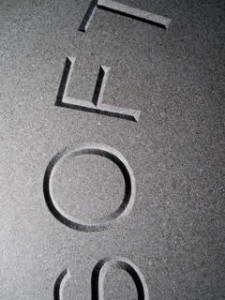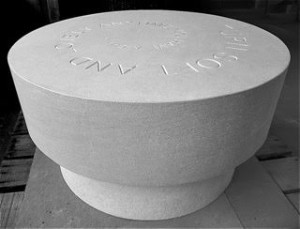New Resident Brings Age-Old Craft to Town
Carving Stone: Adam Paul Heller
By Lindsey Pizzica Rotolo
 “I wish I was a slave to an age-old trade…” begins “Down in the Valley”, a song by the indie folk band The Head & the Heart. The song expresses a deep yearning to get back to your roots, and lead a more primitive existence. In this technology age, with fewer and fewer people engaged in work that can be accomplished without a screen or a gadget, artisans like Adam Paul Heller are rare.
“I wish I was a slave to an age-old trade…” begins “Down in the Valley”, a song by the indie folk band The Head & the Heart. The song expresses a deep yearning to get back to your roots, and lead a more primitive existence. In this technology age, with fewer and fewer people engaged in work that can be accomplished without a screen or a gadget, artisans like Adam Paul Heller are rare.
A slave to the 2,000-year-old tradition of stone carving, Heller moved to Norfolk in the summer of 2014. “It’s a very conscious choice to live in Norfolk. You have to feel it,” Heller says. Stepping into his studio is its own sensorial experience, as an immediate sense of calm envelops you. Here is a place where time stands still. Surrounded by raw materials: wood, stone and metal, and ageless tools—it could be 1950, or 1650 for that matter. The frantic pace of modern life has no place here; there are no machines or devices beeping or chirping—just an artisan of old with his craft, and his cats.
Heller and his wife, Sara, a psychotherapist, were drawn to Norfolk immediately. “Norfolk calls to you. It spoke to us, and we answered the call.” Tom McGowan gave the Hellers a tour of town, and then showed them a house on Grant Street—they knew immediately that it would be their home.
 Previously, they lived in Foster, Rhode Island, which had the rural, romantic appeal they craved, but no town center, and then West Warwick, Rhode Island which had industry, but lacked identity. “Neither town had the invested complex and wonderful community involvement of little Norfolk,” Heller says. The Hellers have two young children; Liam, a third grader at Botelle School and a two-year-old daughter, Mia, who spends a portion of her days at the Norfolk Early Learning Center.
Previously, they lived in Foster, Rhode Island, which had the rural, romantic appeal they craved, but no town center, and then West Warwick, Rhode Island which had industry, but lacked identity. “Neither town had the invested complex and wonderful community involvement of little Norfolk,” Heller says. The Hellers have two young children; Liam, a third grader at Botelle School and a two-year-old daughter, Mia, who spends a portion of her days at the Norfolk Early Learning Center.
Heller’s evolution as a stone carver began with block printing as an undergraduate at the University of Vermont in the early 1990’s. He spent his junior year in India, engrossed in their age-old traditions. While staying at a monastary in Darjeeling, Heller was overwhelmed by how grounding the Buddhists’ deep, personal connection to humanity was, and began thinking about bringing some form of art into that relationship.
He first began carving stone after his undergraduate studies concluded, while interning in Bethlehem, Conn. at the Abbey of Regina Laudis, a Benedictine sisterhood. He spent two years there with Mother Praxedes Baxter, who was trained in marble carving by DeTomassi master carvers in Rome.
 Heller then moved to Rhode Island and began a rare three-year apprenticeship at the John Stevens Shop in Newport, a 310-year-old stone carving and lettering enterprise that had seven generations of the Stevens family (and now three generations of the Benson family) at the helm. One of the oldest continuously run businesses in the country, the John Stevens Shop produces a very precise Roman tradition of lettering.
Heller then moved to Rhode Island and began a rare three-year apprenticeship at the John Stevens Shop in Newport, a 310-year-old stone carving and lettering enterprise that had seven generations of the Stevens family (and now three generations of the Benson family) at the helm. One of the oldest continuously run businesses in the country, the John Stevens Shop produces a very precise Roman tradition of lettering.
Heller next went to work for Karen Sprague, also in Rhode Island. She met with the clients, while Heller immersed himself in the letter design and carving. Eight years ago, he began his own version of the craft. While his letters are Roman-inspired, he is not bound by any specific tradition. “I let every piece be what it is meant to be,” Heller says.
He explained that making a headstone for a family requires an intimate understanding of who the person was. Heller often meets with family members several times, as some of the most important aspects of a person’s being are not revealed on the first  meeting. One headstone that he is currently working on includes an image from a piece of African art that the deceased treasured. “The process is slow, and the stone is slow, but we can take the time. It’s a true collaboration with every client and every project.”
meeting. One headstone that he is currently working on includes an image from a piece of African art that the deceased treasured. “The process is slow, and the stone is slow, but we can take the time. It’s a true collaboration with every client and every project.”
Heller also collaborates with other artists on projects all over the world. Most recently, Heller was in Philadelphia “purposefully rusticating” a series of 22 granite benches on the Woodlands Walk at the University of Pennsylvania campus. The benches are part of conceptual artist Jenny Holzer’s “125 Years,” (a tribute to 125-years of women’s contributions to Penn) that had been damaged by wear and tear over the past decade.
Heller is giving a talk on his craft at the library on Sunday, October 18 at 4 p.m. Photographs of his work and information about his process can be found on his website, www.adampaulheller.com.
Photo, top, by Bruce Frisch. All other photos courtesy of Ada Paul Heller.

